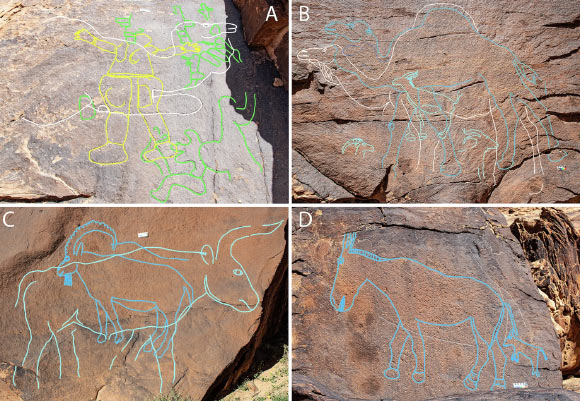During the Pleistocene-Holocene transition (around 12,000 years ago), humans exploited a network of seasonal water bodies in the interior of northern Arabia, marking locations and access routes with monumental rock engravings of camels, ibex, wild equids, gazelles, and aurochs.
As part of the Green Arabia Project, Griffith University archaeologist Michael Petraglia and his colleagues identified more than 60 rock art panels containing 176 engravings in three previously unexplored areas — Jebel Arnaan, Jebel Mleiha, and Jebel Misma — along the southern edge of the Nefud Desert in northern Saudi Arabia.
The engravings, primarily depicting camels, ibex, equids, gazelles, and aurochs, include 130 life-sized and naturalistic figures, some measuring up to 3 m long and more than 2 m high.
The engravings date to between 12,800 and 11,400 years ago, a period when seasonal water bodies reappeared in the region following extreme aridity.
These water sources, confirmed through sediment analysis, supported early human expansions into the desert interior and offered rare opportunities for survival.
“These large engravings are not just rock art — they were probably statements of presence, access, and cultural identity,” said Dr. Maria Guagnin, an archaeologist at the Max Planck Institute of Geoanthropology.
“The rock art marks water sources and movement routes, possibly signifying territorial rights and intergenerational memory,” added Dr. Ceri Shipton, an archaeologist at University College London.
Unlike previously known sites where engravings were hidden in crevices, the Jebel Mleiha and the Jebel Arnaan panels were etched onto towering cliff faces, some up to 39 m high, in visually commanding locations.
One panel would have required ancient artists to climb and work precariously on narrow ledges, underscoring the sheer effort and significance of the imagery.
Various artifacts, including Levantine-style El Khiam and Helwan stone points, green pigment, and dentalium beads, suggest long-distance connections to Pre-Pottery Neolithic (PPN) populations in the Levant region.
However, the scale, content, and placement of the Arabian engravings set them apart.
“This unique form of symbolic expression belongs to a distinct cultural identity adapted to life in a challenging, arid environment,” said Dr. Faisal Al-Jibreen, a researcher with the Heritage Commmission at Saudi Ministry of Culture.
“The project’s interdisciplinary approach has begun to fill a critical gap in the archaeological record of northern Arabia between the Last Glacial Maximum and the Holocene, shedding light on the resilience and innovation of early desert communities,” Dr. Petraglia said.
The team’s paper was published in the journal Nature Communications.
_____
M. Guagnin et al. 2025. Monumental rock art illustrates that humans thrived in the Arabian Desert during the Pleistocene-Holocene transition. Nat Commun 16, 8249; doi: 10.1038/s41467-025-63417-y








